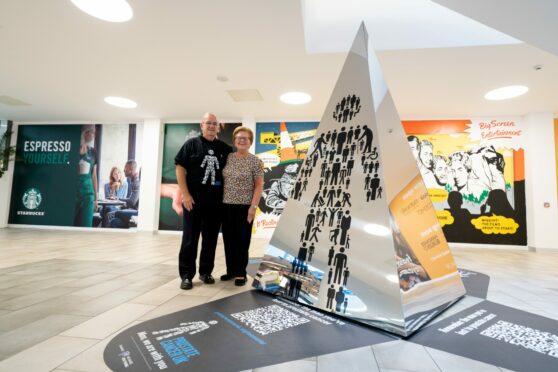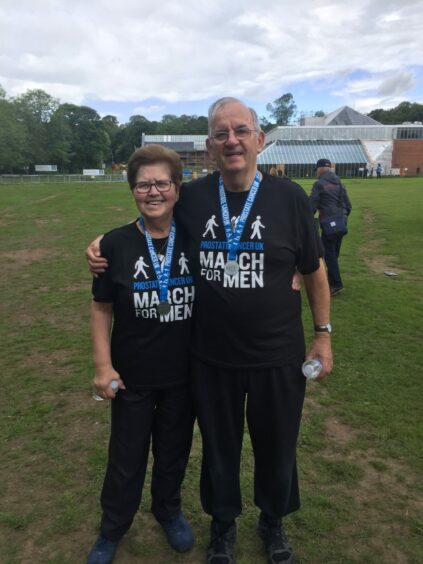
Men should check their risks for prostate cancer to catch the disease early, even if they don’t have symptoms, advises Prostate Cancer UK.
Prostate cancer is the most common cancer in men. Across Scotland, 3,000 men are diagnosed and 1,000 lose their lives to the disease each year.
Yet prostate cancer is often treatable if caught early but, with no early symptoms, it’s crucial that men, and their loved ones, know and understand their risks. This is why the charity is raising awareness of its 30-second online risk checker, which can help men determine if they could be at a greater risk of prostate cancer.
“Early diagnosis saves lives as prostate cancer is treatable and curable when caught early but it can be tricky as early prostate cancer often doesn’t have symptoms,” said Chiara De Biase of Prostate Cancer UK. “That’s why we’re encouraging men to answer three simple questions on the risk checker to help them quickly understand their risk of getting prostate cancer.”
Prostate Cancer UK also hopes a new touring memorial sculpture that is embossed with the names of 500 men who have lost their lives to prostate cancer will help to raise awareness.
Among those named is Albert Graham, who died in 2014 following a two-year battle with the disease. Eight years on, his wife, Ann Graham, volunteers with Prostate Cancer UK to raise awareness and support men and families living with a diagnosis.
“Albert was diagnosed aged 64 and we were stunned as neither of us knew anything about prostate cancer,” said Graham, 62, from Dundee.
“I’d encouraged him to see the GP as he was having urinary problems, needing the toilet at night and had lower back pain, even though he didn’t want to as he was embarrassed.
“Albert had locally advanced prostate cancer, meaning it had spread from the prostate gland into the surrounding tissue. He had symptoms at that stage but now I know there are no early symptoms so it’s about knowing what risk category you are in.”
She is proud to see her husband’s name on the memorial and hopes her efforts volunteering with the charity could see more men catch the disease earlier.
Graham encourages all men aged over 50 to determine their risk and book in with their GP for further checks if necessary, and men over 40 if there is a history of prostate cancer in the family.
She added: “If we had any inkling it could have been prostate cancer, I would have encouraged Albert to go to the GP earlier. I don’t want anybody to go through what we did. I just want men to realise that they can’t ignore it, it’s not just an old-age problem, and there is hope if you catch it early enough.”
Prostate cancer can be treated with active surveillance, where a person’s PSA levels are monitored with tests, or hormone treatments, radiotherapy, brachytherapy or a radical prostatectomy, which removes the prostate gland and surrounding tissue.
“Prostate cancer is more common in men aged over 50 and the risk can increase with age. One in eight men will be diagnosed with prostate cancer, but that risk doubles for black men and for men with a family history,” said De Biase.
“Our aim is to get more men diagnosed with early stage disease where there are many excellent curative treatment options.
“Be proactive and don’t wait for symptoms. If men understand their risk, they can discuss having a simple blood test called a PSA blood test, which can indicate if something is wrong with the prostate. Those men at highest risk can have further investigations and hopefully catch prostate cancer early and get a cure.”
Another recent name on the 10ft pyramid-shaped Prostate Cancer Memorial is BBC Breakfast presenter Bill Turnbull, who died in August aged 66.
The announcement of his diagnosis in 2018 led to a spike in referrals and saw it become the most commonly diagnosed cancer for the first time that year.
That legacy continues as the charity’s online risk checker saw an additional 61,000 people check their risk of the disease in the week following his death.
After his diagnosis, Turnbull urged families: “If you’re worried about your dad, or your husband or your uncle, for heaven’s sake tell them to get checked.
“I’ve had so many people get in touch and say, ‘Yeah I got checked, I got diagnosed and we caught it early, and as a result, the future is a lot brighter’ but if you don’t do that, then it’s a different picture.”
Ian’s story: Five-minute chat that saved my life
Fourteen years on from his prostate cancer diagnosis, Ian Cassels is still clear of the disease and determined to raise awareness among men.
Cassels, from Darvel, Ayrshire, was diagnosed in 2007, aged 60.
“I was a retired firefighter and a football referee so I was relatively fit and healthy,” said Cassels, 75.
“I’d been in about a sore toe and my doctor asked for a chat about my health in general. I told her I had ‘the old man’s problem’, going to the toilet frequently, often having to rush. She told me there might be something wrong with my prostate and did some tests.”
A biopsy confirmed prostate cancer. “The doctor said my prognosis was good as I was young, well 60, fit and healthy and they had caught it before it had spread,” said Cassels.
Two months later, he underwent a radical prostatectomy, a procedure to remove his prostate.
“Now, 14 years on, I’m still cancer-free.”
Cassels, who runs a Prostate Cancer UK support group in Kilmarnock, advises men to look at the online risk checker.
“It’s quick to check your risk. Any man in their 40s or 50s with any symptoms or risks, I’d say have a word with your doctor and they can advise you if you need a test or not,” he said. “My son, 45, gets tested every five years.
“I count my blessings I’m still here but if it hadn’t been for a five-minute chat with a doctor things might have been different.”
Prostate Cancer UK’s Risk Checker can be found at prostatecanceruk.org/risk-checker

Enjoy the convenience of having The Sunday Post delivered as a digital ePaper straight to your smartphone, tablet or computer.
Subscribe for only £5.49 a month and enjoy all the benefits of the printed paper as a digital replica.
Subscribe